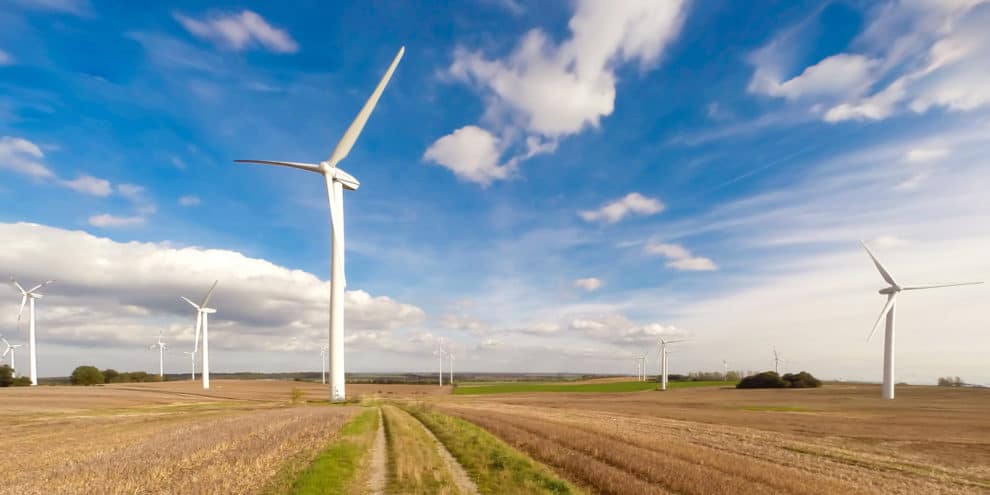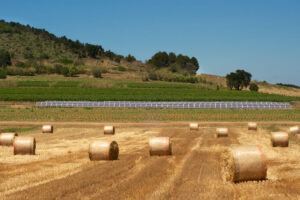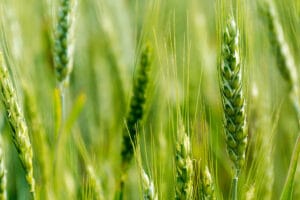When farmers consider whether to install wind turbines on their land, there are the obvious things to think about. Firstly, of course, being the financial boom that wind turbines can generate for the farm and the community. (According to the U.S. Department of Energy (DOE), the wind power industry is expected to invest $60 billion to rural America, and $1.2 billion in new income to farmers and rural landowners and provide 80,000 new jobs during the next 20 years.1)
This financial benefit is huge for farmers. The pay checks from wind turbines have helped farms stay in families, and have helped farming operations run more smoothly, with less of the financial ups and downs that farmers know all too well. But according to recent (and very exciting) research, there’s a hidden perk. Turns out, it’s not just the farmer’s wallet that benefits from wind turbines. The very crops farmers grow are strengthened by the presence of the turbines. How? Read on.
Wind Turbines Mix the Air and Provide more Carbon Dioxide to Plants
Eugene Takle, an agricultural meteorologist at Iowa State University, tells National Geographic2 that “the job of the corn is to take up as much CO2 as it can”. Wind turbines act as giant fans that move the air around the crops, mixing up the atmosphere and allowing more CO2 movement around the crops. This helps crops grow faster.
According to NASA, an increase in carbon dioxide boosts crop yields by “increasing the rate of photosynthesis, which spurs growth.” A boost in CO2 also reduces water loss through transpiration. Crops tend to sweat through “pores” called stomata, and when there’s more CO2 in the atmosphere, crops use their water more efficiently.3
Wind Turbines Reduce Fungal Disease in Crops
Windier conditions overnight means less dew on the leaves, which ultimately means that there’s less opportunity for harmful fungal diseases to grow on crops. This is a welcome change, especially for parts of the Midwest like Iowa, where climate change has made the air more humid, making dew more common. As evening temperatures drop, the air cools to the dew point, which forms condensation on the leaves. This moisture causes common fungal diseases in plants, such as Botrytis and powdery mildew.4
Agricultural scientists suggest that keeping the air dry (such as in greenhouses) can help suppress fungal diseases, especially from dusk to dawn. Perhaps the best way for farmers to control humidity for plant health is through encouraging overnight winds with wind turbines. Farmers who install wind turbines may notice crops with less disease, especially in humid regions.
Wind Turbines Make Nights Warmer and Days Cooler for Crops
The effect that wind turbines have on the atmosphere means more stabilized temperatures. According to a study conducted by Iowa State University5, wind turbines change the temperature of the air around them, leading to about half-degree cooler days and a half-to-full degree warmer nights. The turbulence created by wind turbines mixes the air at different elevations, bringing cooler air down to the earth during the day and mixing warm air down toward the crops at night.
What does this mean? It means less frost at night and less sweltering heat during the day. It means fewer temperature variations that crops must contend with, and less damage due to frost, over-drying, and overheating.
There’s no doubt that wind turbines affect the growing conditions of crops. Scientists are finding that the presence of wind turbines could improve the efficiency of crop growth, especially in more humid climates, such as Iowa and other parts of the Midwest. “The next step would be to answer if this turbulence changes biomass uptake of plants, or if it affects plant size or functions or yield,” says Eugene Takle. It will be interesting to see how wind turbines strengthen the American farm in years to come.
Written by Marissa Afetian, Administrative Coordinator at Alcen Renewable in California. Alcen Renewable builds utility scale and commercial renewable energy projects.
This content may not be used or reproduced in any manner whatsoever, in part or in whole, without written permission of LANDTHINK. Use of this content without permission is a violation of federal copyright law. The articles, posts, comments, opinions and information provided by LANDTHINK are for informational and research purposes only and DOES NOT substitute or coincide with the advice of an attorney, accountant, real estate broker or any other licensed real estate professional. LANDTHINK strongly advises visitors and readers to seek their own professional guidance and advice related to buying, investing in or selling real estate.










Add Comment